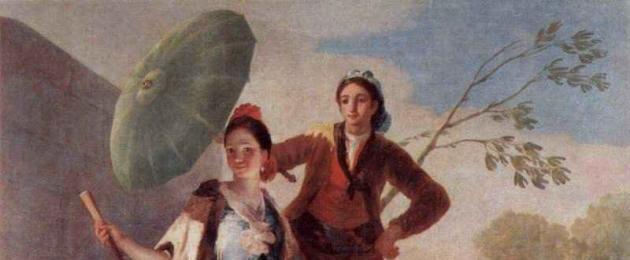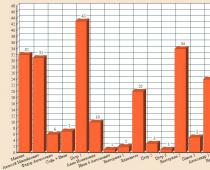Francisco José de Goya, Spanish painter
Goya Francisco José de, Goya y Lucientes (Goya y Lucientes) (1746-1828), Spanish painter, engraver, draftsman. From 1760 he studied in Zaragoza with X. Lusan y Martinez. Around 1769 went to Italy. In 1771 he returned to Zaragoza, where he painted frescoes in the tradition of the Italian Baroque (side nave of the church of Nuestra Señora del Pilar, 1771-72). From 1773 he worked in Madrid. In 1776-80 and 1786-91, he completed over 60 panels (cartons for carpets) for the royal manufactory with scenes of everyday life, work and festive folk entertainment rich in color and laid-back in composition.  ("Umbrella", 1777, "Game of Pelota", 1779. "Wounded Mason", 1786, "Game of Bluff", 1791 - all in the Prado).
("Umbrella", 1777, "Game of Pelota", 1779. "Wounded Mason", 1786, "Game of Bluff", 1791 - all in the Prado).
In contrast to the spirit of ceremonial solemnity and rationality that reigned in Spanish painting, Goya's cardboards were imbued with love for life and natural beauty. From the beginning of the 80s. Goya also gained fame as a portrait painter ("Family of the Duke of Osun", 1787, Prado; "Portrait of the Marquise A. Pontejos", about 1787, National Gallery of Art, Washington). His portraits are made in a sonorous, subtly designed color scheme, the figures and objects in them, conveyed with a subtle sense of their materiality, seem to dissolve in a light haze.
In 1780 Goya was elected to the Madrid Academy of Arts (from 1785 vice-director, and from 1795 director of its painting department), in 1786 he was appointed court painter, from 1799 "the first painter of the king." During this period of the coming political reaction in Spain, the life-affirming beginning in the work of Goya is replaced by a deep  dissatisfaction, acquiring features of tragedy. Goya is attracted by the art of graphics: the swiftness of the pen drawing, the scratching stroke of the needle in the etching, the chiaroscuro effects of the aquatint. Under the influence of the Spanish enlighteners (G. M. Jovellanos y Ramirez, M. X. Quintana), Goya's dislike for feudal-clerical Spain escalated.
dissatisfaction, acquiring features of tragedy. Goya is attracted by the art of graphics: the swiftness of the pen drawing, the scratching stroke of the needle in the etching, the chiaroscuro effects of the aquatint. Under the influence of the Spanish enlighteners (G. M. Jovellanos y Ramirez, M. X. Quintana), Goya's dislike for feudal-clerical Spain escalated.
In the 1790s - early 1800s. Goya's portrait work reached an exceptional flowering, in which a feeling of disturbing loneliness of a person sounded (portraits - seniors Bermudez, Museum of Fine Arts, Budapest, F. Bayeu, 1796, Prado, F. Savas Garcia, circa 1805, National Gallery of Art, Washington), courageous confrontation and challenge to the outside world ("La Tirana", 1799, Academy of Arts, Madrid; portraits - Dr. Peral, 1796, National Gallery, London, F. Guillemarde, 1798, Louvre). With amazing accusatory power of unvarnished truth, the artist captures the arrogant solemnity and ugliness of the royal family in the group portrait "The Family of Charles IV" (1800, Prado). The aroma of mystery and hidden sensuality is shrouded in the image of a woman in the paintings "Maja Dressed" and "Maja Nude" (both - around 1802, Prado).
In a large series of etchings "Caprichos" (80 sheets with the artist's comments, 1797-98, published at the beginning of 1799), the ugliness of the moral, political and spiritual foundations of the Spanish "old order" is revealed in a grotesque-tragic form, nourished by folklore sources. The series "Caprichos" is distinguished by the bold novelty of the artistic language, the sharp expressiveness of lines, restless spots and strokes, contrasts of light and shadow, appeal to the grotesque, allegory, artistic exaggeration and allegory. Deep historicism, genuinely popular energy and passionate protest permeate Goya's large paintings dedicated to the struggle against the French intervention: "The Uprising of May 2, 1808 in Madrid" and "The Execution of the Rebels on the Night of May 3, 1808" (both - around 1814, Prado). A kind of philosophical and historical understanding of the fate of the people in this tragic era in the history of Spain were the etchings "The Disasters of War" (82 sheets; 1810-20, published in 1863 in Madrid).
In the early 1790s. a serious illness led the artist to deafness. The last, extremely difficult years for him, which coincided with a period of cruel reaction, Goya spent in a country house ("Quinta del Sordo", that is, "The House of the Deaf"), the walls of which he painted with oil. The scenes created here (now in the Prado), including unprecedentedly bold for that time, dynamic images of crowded masses and frightening symbolic images, embodied the ideas of confrontation  past and future, endlessly insatiable, decrepit image of time ("Saturn") and the liberating energy of youth ("Judith"). Even more complex is the system of gloomy grotesque images in the series of etchings "Disparates" (22 sheets; 1820-23, published in 1863 in Madrid under the title "Proverbs"). But even in Goya's darkest visions, cruel darkness cannot suppress the artist's inherent sense of perpetual motion, which for him, as for the revolutionary romantics in France, was a powerful manifestation of life. It becomes a leitmotif in The Funeral of the Sardine (circa 1814, Prado), in the series of etchings Tauromachia (1815, published in 1816 in Madrid) and other works. From 1824 Goya lived in France, where he painted portraits of his friends, mastered the technique
past and future, endlessly insatiable, decrepit image of time ("Saturn") and the liberating energy of youth ("Judith"). Even more complex is the system of gloomy grotesque images in the series of etchings "Disparates" (22 sheets; 1820-23, published in 1863 in Madrid under the title "Proverbs"). But even in Goya's darkest visions, cruel darkness cannot suppress the artist's inherent sense of perpetual motion, which for him, as for the revolutionary romantics in France, was a powerful manifestation of life. It becomes a leitmotif in The Funeral of the Sardine (circa 1814, Prado), in the series of etchings Tauromachia (1815, published in 1816 in Madrid) and other works. From 1824 Goya lived in France, where he painted portraits of his friends, mastered the technique
- In contact with 0
- Google Plus 0
- OK 0
- Facebook 0








